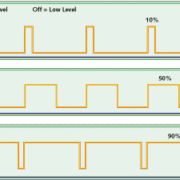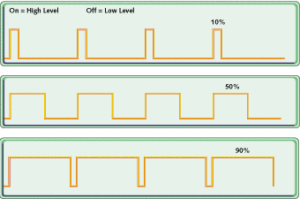Pulse Width Modulation
Our Infinitybox System is far different from a traditional fuse & relay based wire harness. There are things that Infinitybox can do that you couldn’t even begin to imagine with a good-old bundle of wire. One of our biggest goals when we educate people about our products is to de-mystify some of the potentially scary terms that we use. One that we use a lot is Pulse Width Modulation or PWM. This is a fancy term for turning something on and off very fast to control power.
We don’t use relays in our POWERCELLs. Instead, we use MOSFETs. Yes, I know that is another scary term that we’ll talk about later. For now, all you need to know is that MOSFETs are solid state stitches. Unlike relays, there are no mechanical parts in them. You can turn a MOSFET on and off literally millions of times per second. You can do that with a relay 2 to 3 times per second before you have to worry about burning up the contacts.
The ability to turn a MOSFET on and off very quickly allows us to control the amount of power coming out of a POWERCELL output. We do this by using something called Pulse Width Modulation. PWM is the process of turning an output on and off quickly. The effective power coming out of the output is proportional to the amount of on time as compared to the off time. The ratio of the on time versus the off time is called the duty cycle. So for example, if we turn the output on for half of the cycle time and off for the other half, your duty cycle is 50%. The effective voltage of your output is approximately 50%. This picture shows you what we mean.
The three different graphs are 10%, 50% and 90% duty cycle.
Check out this video showing you more about PWM. If you haven’t seen Colin’s Lab on You Tube before, it is a worthwhile watch. He is a geek’s geek but makes great videos explaining the basics of electronics. As part of Make Magazine, his stuff is filled with tons of useful electronics projects, tips and tricks.
So you’re asking yourself, “What does this mean to me”? “I’m wiring a car, not building circuits.” Pulse Width Modulation is a very effective and efficient way to control the brightness of lights and the speed of motors. There is very little heat lost with PWM as compared to using resistors or rheostats.
The Infinitybox system has PWM capability built into the POWERCELL outputs. We can effortlessly dim lights, create daytime running lights, theater dim interior lights, control fan speeds, and fuel pump speeds. For those who need that advanced control, it is built right into your system. No external modules or hardware are required.


